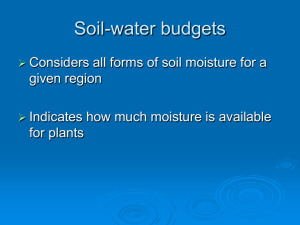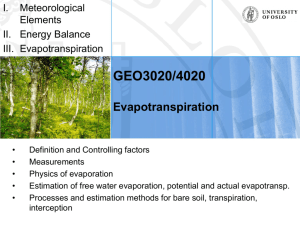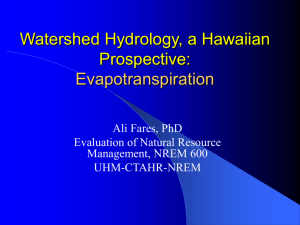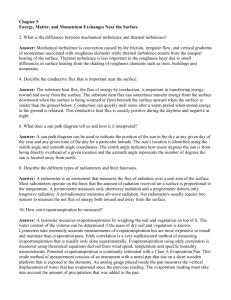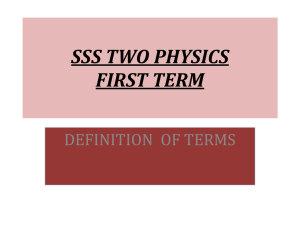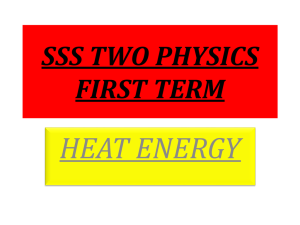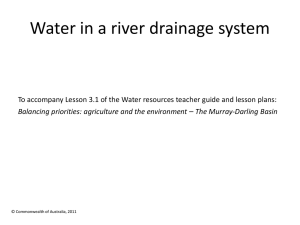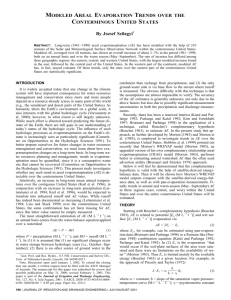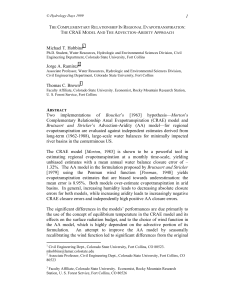ele12211-sup-0001-AppendixS1
advertisement
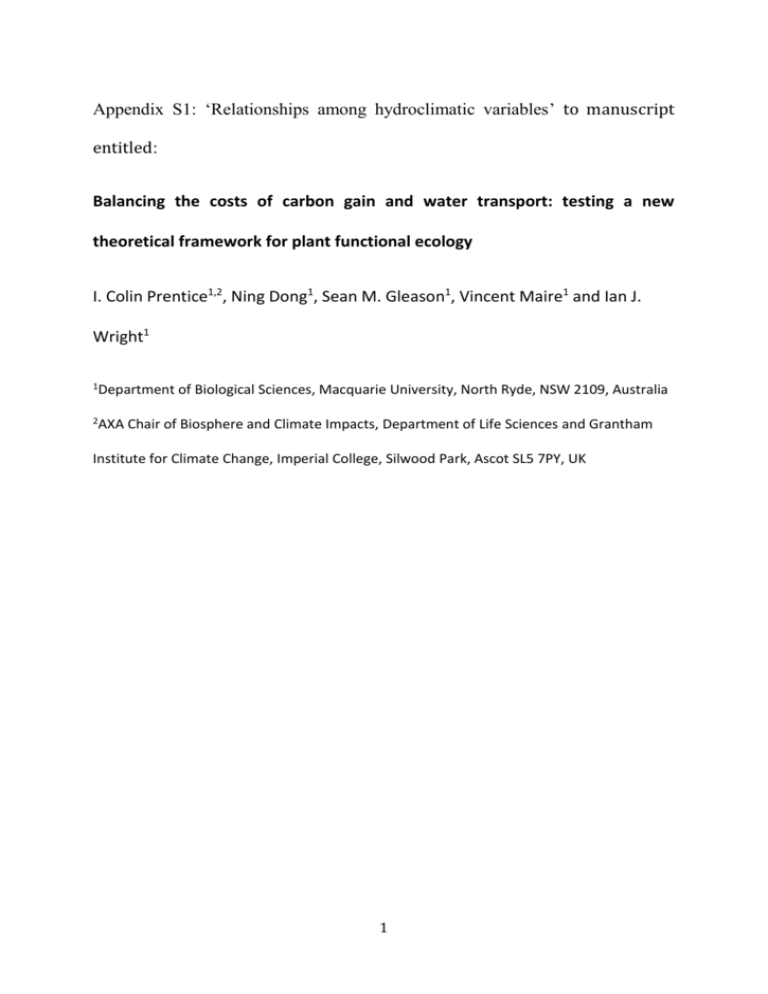
Appendix S1: ‘Relationships among hydroclimatic variables’ to manuscript entitled: Balancing the costs of carbon gain and water transport: testing a new theoretical framework for plant functional ecology I. Colin Prentice1,2, Ning Dong1, Sean M. Gleason1, Vincent Maire1 and Ian J. Wright1 1Department 2AXA of Biological Sciences, Macquarie University, North Ryde, NSW 2109, Australia Chair of Biosphere and Climate Impacts, Department of Life Sciences and Grantham Institute for Climate Change, Imperial College, Silwood Park, Ascot SL5 7PY, UK 1 Principles Transpiration depends on D and gs according to Fick’s law: E = 1.6 gsD (S1.1) Here gs refers to stomatal conductance to CO2 (hence the factor 1.6, as water vapour diffuses faster then CO2) and D refers to the immediate driving force for transpiration, which is the vapour pressure deficit of the air surrounding the leaf. The vapour pressure deficit is (es ea) where es is the saturated vapour pressure of water at the current temperature, and ea is the actual vapour pressure. The units of D in equation (S1.1) are implicitly mol mol-1 but values measured in kPa can be readily converted to these units through division by the atmospheric pressure. D varies rapidly on a subdaily time scale, above all due to variations in temperature which cause the saturated vapour pressure to change over a much larger range than the actual vapour pressure. Actual vapour pressure varies more slowly, in part according to weather conditions, and in part in response to the total evaporation rate from the surrounding land surface. Thus although vapour pressure deficit is highly dynamic on short time scales, when considered over large areas and timescales of months, variations in D are expected to follow trends in the availability of water for evaporation and transpiration. So for example extended rainy periods are expected to be accompanied by mainly low values of D, while droughts will be accompanied by higher values of D. E in equation (S1.1) refers to the instantaneous rate of water loss from the leaf by diffusion through the stomata. We are interested in the relationship between local, instantaneous fluxes and larger-scale, longer-term average quantities that can be derived from climate data. Largescale actual evaporation (Ea) includes transpiration, but also includes water loss from wet leaf surfaces during and after rain (interception) and by evaporation from the ground surface and 2 open water, if present. Ea can be reduced by restricted water supply, reduced foliage cover, and/or stomatal closure in response to high D or dry soils resulting in lowered transpiration rates. The extent of this reduction can in principle be gauged by comparing Ea with a ‘reference value’ of evapotranspiration, corresponding to idealized conditions with an abundant supply of water to be evaporated. This reference value is commonly called potential evapotranspiration (Ep). However, there is no universal definition of Ep. Various formulations can differ considerably (Fisher et al. 2011). In particular, evaporation from an open water ‘pan’ located in a dry environment can considerably exceed the evapotranspiration from a stand of vegetation under well-watered conditions, although both quantities can be called ‘potential evaporation’. A better-defined reference value is the equilibrium evapotranspiration (Eq). Eq is the evapotranspiration theoretically to be expected from a homogeneous, well-watered surface under constant atmospheric conditions (Raupach 2000). It is given by a succinct formula: λEq = Rn. s/(s + γ) (S1.2) where λ is the latent heat of vaporization of water, Rn is the net radiation at the surface (the balance of incoming and outgoing short- and long-wave radiation), s = ∂es/∂T (the slope of the saturated vapour pressure of water as a function of temperature), and γ is the psychrometer constant. There are standard methods to calculate most of the terms in (S1.2). λ is nearly constant over the temperature range of interest; γ is dependent on atmospheric pressure; s follows from the Clausius-Clapeyron relationship, for which close approximations are in common use. To estimate Rn we use the method introduced by Linacre (1968), which requires the calculation of shortwave radiation at the top of the atmosphere, a typical value for the shortwave albedo of the vegetation surface, and data on fractional sunshine hours and temperature (Gallego-Sala et al. 2010). 3 A definition closely related to (S1.2) is the Priestley-Taylor potential evapotranspiration, (1 + ω) Εq where ω ≈ 0.26. This expression arises from measurements showing that evapotranspiration under idealized conditions (for example, over open water or continuous vegetation) tends to exceed Eq. The fundamental cause for ω > 1 is the daily growth of the planetary boundary layer, which entrains dry air from the free atmosphere above, violating the condition of equilibrium. However, ω can be smaller or larger than 0.26. For simplicity, we consider ω = 0 in all that follows. The term α is commonly used for the ratio Ea/Eq, and known as the Priestley-Taylor coefficient. If Ea and Eq are total annual values, α has a close empirical and theoretical relationship with the ratio P/Eq, which we refer to as the Moisture Index (MI). The link is the Budyko relationship, a classical hydrological concept usually applied at the river-catchment scale. In the particular mathematical formulation by Zhang et al. (2004), the Budyko relationship states that: Ea = Ep + P (Epw + Pw)1/w (S1.3) where Ep is the Priestley-Taylor potential evapotranspiration, and w ≈ 2 to 3. Equation (S1.3) expresses the transition between the dependence of large-area evapotranspiration on precipitation at low P (‘water limitation’), and on energy supply at high P (‘energy limitation’). Other, superficially different mathematical forms yield closely similar results (Arora 2002, Yang et al. 2008). The corresponding relationship between the dimensionless quantities MI and α (neglecting ω) is: α = 1 + MI (1 + MIw)1/w (S1.4) According to (S1.4), α is approximately proportional to MI at low values of MI, approaching an asymptotic value of unity as MI becomes large. 4 Measures used in this paper We use two environmental variables to characterize the site hydroclimates: Moisture Index (MI) and evaporation deficit, ΔE = Eq Ea = Eq (1 α). We calculated α from climatological data using the Cramer-Prentice algorithm (Cramer & Prentice 1988, Gallego-Sala et al. 2010). This uses monthly precipitation data, and Eq values derived from Linacre’s (1968) approximation for Rn, to compute a generic soil water balance on a ‘quasi-daily’ timestep. In other words, the computation is made daily (for numerical stability) although the precipitation data are monthly, and precipitation is supplied to the soil steadily (in equal amounts on each day of the month) rather than more realistically in discrete events. The soil is represented as a single bucket with 150 mm capacity (note that this type of model has a very low sensitivity to realistic variations in the depth of the bucket, and therefore to soil type). At each timestep, Ea is determined analytically as the daily integral (assuming an idealized sinusoidal time course of short-wave radiation, proportional to the time course of extraterrestrial radiation) of the lesser of two instantaneous quantitities: a ‘demand’ term (Eq) and a ‘supply’ term, taken to be a maximum rate (1 mm h-1) multiplied by W/Wmax, where W is the amount of water in the bucket and Wmax is the available water-holding capacity (150 mm). Runoff occurs whenever W = Wmax. The procedure is started with W = 0 and iterated to convergence on a stable seasonal cycle of W. MI (or its reciprocal, the Aridity Index: Arora 2002) is a simple and widely used general index of climatic water availability. It is more appropriate for many purposes than mean annual precipitation because it recognizes the importance of evaporative demand, which increases towards the tropics, through division by Eq. An alternative rationale for MI is provided by its close relationship to α, as expressed through equation (S1.4). Values of α estimated from MI following equation (S1.4) are highly correlated with values calculated using the Cramer- 5 Prentice algorithm (Wang et al. 2012). MI and α can thus be considered as alternative annual measures of the water supply available to plants. MI has the advantage that high values, even after saturation of α, may still reflect biologically meaningful climatic differences related to the frequency of dry days. Some extreme oceanic ecosystems and species depend on almost continuously wet conditions which are reflected in large values of MI (Gallego-Sala & Prentice 2013). On the other hand, stomata respond to variations in D. Maximum values of D systematically increase towards the tropics because of the steep dependency of es on temperature. To relate D to evapotranspiration, we use the empirical large-area formula introduced by Monteith (1995): Ea = (1 + ω) Eq gs/(Gs + G0) (S1.5) where G0 is an atmospheric parameter, which has been found to vary over only a limited range (Huntingford & Monteith, 1998), and Gs refers to the bulk land-surface conductance. Substituting the relationship Ea = G0D – a large-scale analogue of equation (S1.1) - into (S1.5) yields, after re-arrangement: D = Eq (1 + ω α)/G0 (S1.6) This relationship allows us to derive a long-term ‘effective value’ of D from climatological values of Eq and α. Treating G0 as constant and neglecting ω, we obtain proportionality between ΔE and D and can therefore use the former as a proxy for the latter. Additional references not cited in the main text Arora, V.K. (2002). The use of the aridity index to assess climate change effect on annual runoff. J. Hydrol., 265, 164-177. 6 Cramer, W. & Prentice, I.C. (1988). Simulation of regional soil moisture deficits on a European scale. Norsk Geogr. Tidsskr., 42, 149-151. Fisher, J.B., Whittaker, R.J. & Malhi, Y. (2011). ET come home: potential evapotranspiration in geographical ecology. Global Ecol. Biogeogr., 20, 1-18. Gallego-Sala, A. & Prentice, I.C. (2013). Blanket peat biome endangered by climate change. Nat. Clim. Change, 3, 152-155. Huntingford, C. & Monteith, J.L. (1998). The behaviour of a mixed-layer model of the convective boundary layer coupled to a big leaf model of surface energy partitioning. Bound-Lay. Meteorol., 88, 87-101. Linacre, E. T. (1968) Estimating the net-radiation flux. Agric. Meteorol., 5, 49–63. Monteith, J.L. (1995) Accommodation between transpiring vegetation and the convective boundary layer. J. Hydrol., 166, 251–263 Yang, H., Yang, D., Lei, Z. & Sun, F. (2008). New analytical derivation of the mean annual water-energy balance equation. Water Resour. Res., 44, W03410. Zhang, L., Hickel, K., Dawes, W.R., Chiew, F.H.S., Western, A.W. & Briggs, P. (2004) A rational function approach for estimating mean annual evapotranspiration. Water Resour. Res., 40, W02502. 7

